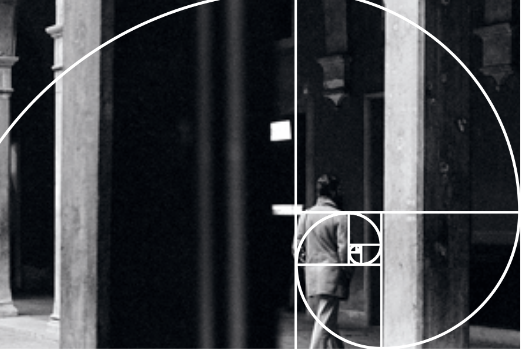Image from Suite Venitienne
The image above is from Sophie Calle’s Suite Venitienne. The image is of a man in a suit, walking in between old-looking columns and arches. He is turned away from the camera so we cannot see his face and the image seems to be taken from a ‘hiding spot’; with the man most likely unaware that he is being photographed. The photo can be described as rather sinister, mysterious and invasive. The genre of this image is most likely documentary, with a possible hint of street photography. It is a naturalistic image, imitating real events instead of a staged ones. The photograph is taken outside but from the shadows, looking out – therefore the lighting is predominately natural. Due to its black and white nature, white balance and the actual colours/tones remain a mystery to the audience. Though, using an online tool, it is possible to colorize and convert the image to its original colours. The original, warm colours hint at a cloudy/shade white balance and a little bit of over-exposure. In reference Ansel Adams’ tonal range, this image is very successful, it captures the blackest black and explores different tones up to the whitest white. Calle would have used a standard 50mm lens to be able to capture the man in full focus from her distance and blur her foreground completely. Though, she mentions in her book, Suite Venitienne, that she owns a Squintar – which is a specific lens that allows the photographer to take a picture of the subject without directly pointing the camera at them. In addition, because of the advantage of natural lighting and sharpness of the lines, it’s likely that Calle used very short shutter speed to capture the image. The image has a certain degree of grain to it but that is most likely from the camera and scanning processes rather than the photograph itself, hence the ISO value used would be low. Visually, the image is peaceful in terms of composition – containing very linear shapes in the columns, windows and street. 
The image follows the golden ratio – drawing our eyes to the subject. The gold ratio generally allows compositions to appear more natural and pleasing to the eye; many studies show that our brain will subconsciously pick images that follow the golden ratio over ones that do not. I know that this image was taken in Venice, the subject is Henri. B, and this image is one out of many Calle has taken following him around. To a viewer who has read the book, the image may feel creepy, disturbing and intrusive as Sophie Calle has taken countless photographs like this one, ones that impose on the day-to-day life of Henri.B. To the larger, unaware audience this image may seem like a perfect, heat of the moment shot. Though still sinister and perhaps a little intrusive, the unaware audience would write this image off as a one-off image – not expecting the same subject to keep appearing. The images for Suite Venitienne were taken during 1980, this particular one has the date of February the 19th.



You need to extend your image analysis beyond the technical and compositional elements of the photograph.
At A2 level we are more interested in interpretation, meaning and context.
Follow this methodology here:
TECHNICAL > VISUAL > CONCEPTUAL > CONTEXTUAL
https://www.photopedagogy.com/photo-literacy.html
To achieve top marks you also need to include others comments in the analysis either from research into what artist has said about his/her work or critics, historians etc.
Here are an interview and articles about her work
https://youtu.be/cRx7nFVuLwA – watch at home. This will give her own interpretation of the meaning behind her work
https://www.theguardian.com/artanddesign/2017/jul/02/sophie-calle-art-interview-what-attracts-me-is-absence-missing-death
Review of her work by Sean O’Hagan
https://www.theguardian.com/artanddesign/2017/mar/04/strangers-secrets-and-desire-the-surreal-world-of-sophie-calle
http://www.anothermag.com/art-photography/7349/sophie-calle-suite-venitienne
You must adopt this critical approach when you are writing your essay. A well written essay is expressing your voice but supported by other people’s point of view – either for or against your own interpretation.
You should be able to use the above articles for your essay too and once you have improved the above image analysis can incorporate it into your paragraph about Sophie Calle